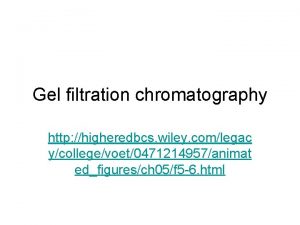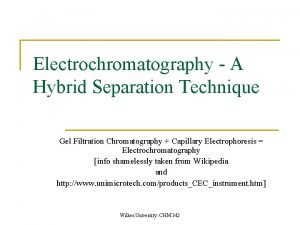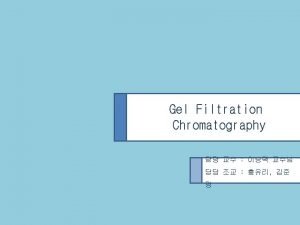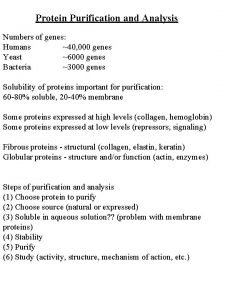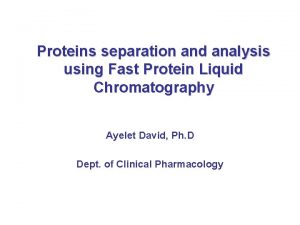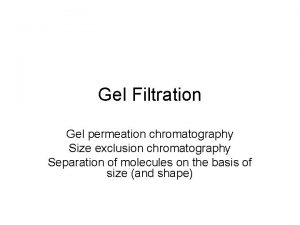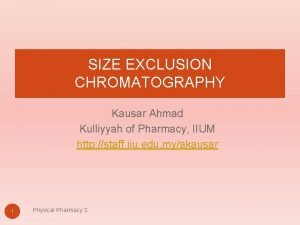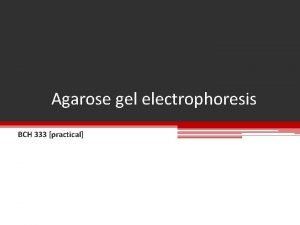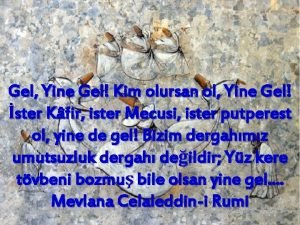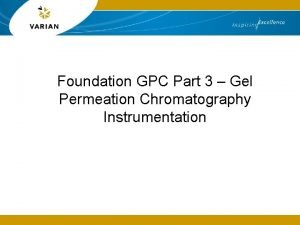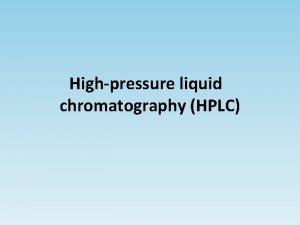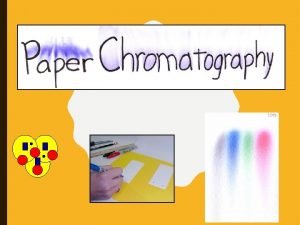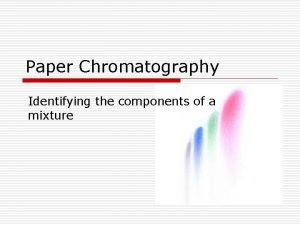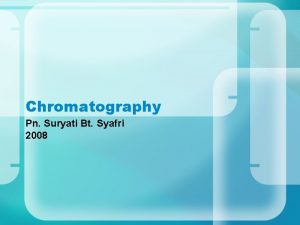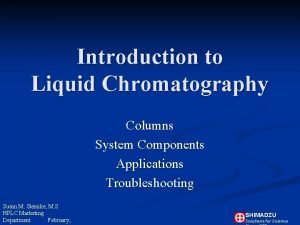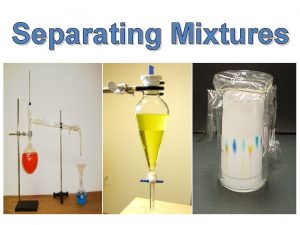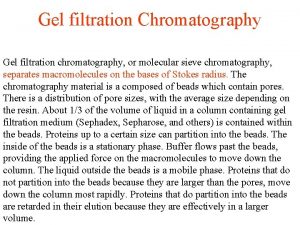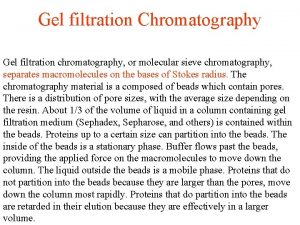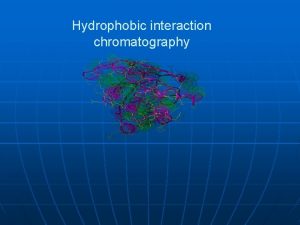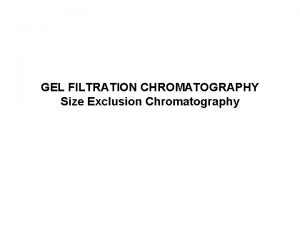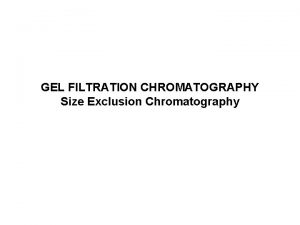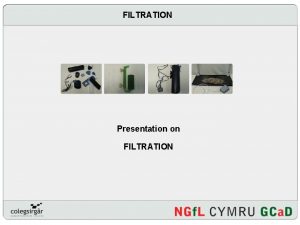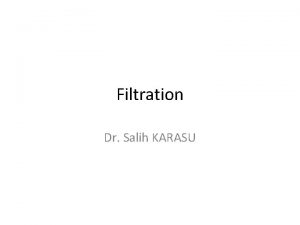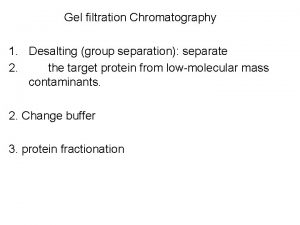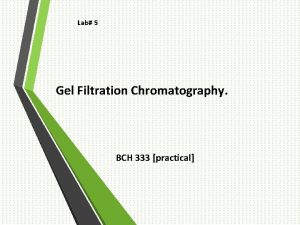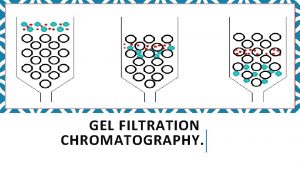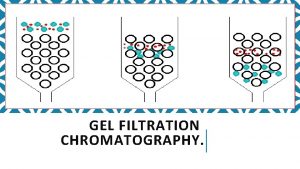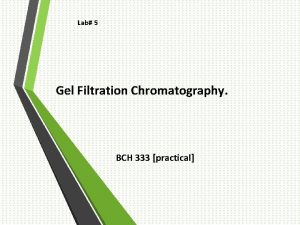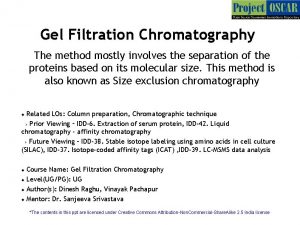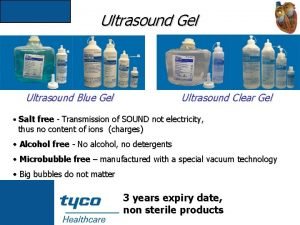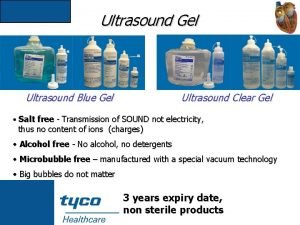Gel Filtration Chromatography vyalswn 2525naver com Application of






















- Slides: 22

Gel Filtration Chromatography 담당 교수: 김대원 교수님 담당 조교: 표민주, 이신정 vyalswn 2525@naver. com



Application of Gel filtration chromatography 1. Purification 2. Buffer change 3. Protein molecular weight determination

1) Chromatography의 종류 - Affinity Chromatography This technique takes advantage of the high affinity of many proteins for specific groups. Specific binding affinity - Ion-Exchange Chromatography Proteins can be separated on the basis of their net charge by ion-exchange chromatography. Charge - Gel Filtration Chromatography More discriminating separations on the basis of size can be achieved by the technique of gel filtration chromatography. Size

2) What is Gel filtration? Principles of gel filtration chromatography A sample containing a mixture of small and large molecules is applied to a gel column. The small molecules can pass into the gel beads and lag behind that can not penetrate into the beads. → molecular sieve the large molecules

3) What is resin? Gel is the stationary phase in the chromatographic bed. This has been cross-linked to form a three-dimensional network. Instead of dissolving in the liquid, they swell, taking up large amounts of liquid. 1. The requirements of gel filtration gel a. Chemical inertness and stability b. Low content of ionic groups c. Uniform particle size d. well-defined range of pore sizes d. High mechanical rigidity

3. What is resin? 2. Various Gel types a. Dextran gels b. Polyacrylamide gels c. Agar and agarose gels 3. Sephacryl gel This makes it possible to work small particles. Sephacryl is intended for use mainly with aqueous eluants. Gel filtration에 사용되는 gel의 종류

4) General practice of Gel filtration 1. Selection of buffer system 2. Packing of the column a. Selection of gel : pore size b. Selection of column (length & diameter) -analytical : long & narrow -preparative : short & wide c. The uniformity of packing

5) Sample application 1. Volume of sample for optimal separation (1 -3% of the total volume) - Because of Diffusion effect 1% 4. 2% 2. Concentration of sample (10 -20 mg/ml, 30 mg/ml at most. Not exceed 70 mg/ml) 3. Viscosity of sample No viscosity


7) Kav를 이용하여 분자량 구하기 1. Standard solution (Blue dextran, Conalbumin, Ribonuclease A, Aprotinin)을 먼저 column에 걸어준다. 280 nm에서 흡광도를 측정한 뒤 그래프를 그린다. Standard sample size Standard sample elution 순서 blue dextran (2000 k. Da) Conalbumin (75 k. Da) 1. Blue dextran Ribonuclease A (13. 7 k. Da) Aprotinin (6. 5 k. Da) 3. Ribonuclease A 2. Conalbumin 4. Aprotinin Ve의 결정: graph에서 peak을 이루는 fraction의 elution volume을 Ve로 정한다.

7) Kav를 이용하여 분자량 구하기 2. Standard curve 구하기. Kav = (Ve-Vo) / (Vt-Vo) Conalbumin (75000 Da) , Ribonuclease A (13700 Da), Aprotinin (6500 Da) Kav 값과 이미 분자량을 알고 있기에, 이 두 값을 x축, y축으로 curve를 구한 다. Vt = packing된 resin의 부피 Vo = void volume, blue dextran 이 나오는 부피 Ve = 단백질이 나오는 부피 EX> Mw(Da) log. Mw Ve (ml) blue Dextran 2000000 Conalbumin 75000 4. 875061 6. 65 Ribonuclease A 13700 4. 136721 8. 4 Aprotinin 6500 3. 812913 11. 2 4. 9 * Blue dextran은 Vo를 측정하기 위함이므 로 standard curve에는 포함되지 않는다.






3. Q & A


<Gel filtration result> ▼ 0. 060 Abs at 280 nm 0. 050 ▼ 0. 040 ▼ 0. 030 0. 020 Vt : 4 ml Vo : 1. 6 ml Vtube : 1. 7 ml ▼ 0. 010 0. 000 1 -0. 010 3 5 7 -0. 020 9 11 13 15 17 19 21 23 25 27 29 Fraction no. <Standard curve> 6 5 4 log. MW STD Sample Fraction 280 nm Total vol. (ml) no. 1 0. 001 -1. 49 2 0. 003 -1. 28 3 0. 000 -1. 07 4 0. 000 -0. 86 5 0. 000 -0. 65 6 -0. 003 -0. 44 7 -0. 006 -0. 23 8 -0. 007 -0. 02 9 -0. 008 0. 19 10 -0. 009 0. 4 11 0. 004 0. 61 12 0. 037 0. 82 13 0. 041 1. 03 14 0. 056 1. 24 15 0. 051 1. 45 16 0. 035 1. 66 17 0. 024 1. 87 18 0. 036 2. 08 19 0. 023 2. 29 20 0. 017 2. 5 21 0. 013 2. 71 22 0. 023 2. 92 23 0. 014 3. 13 24 0. 010 3. 34 25 0. 007 3. 55 26 0. 008 3. 76 27 0. 004 3. 97 28 -0. 004 4. 18 29 -0. 005 4. 39 30 -0. 005 4. 6 3 R 2 = 0. 9517 2 1 0 0 0. 2 proteins Blue dextran Conalbumin RIbonulcease A Aprotinin 0. 4 Kav 0. 6 Kav M. W. 0 2, 000 0. 217105 75, 000 0. 796053 13, 700 1. 085526 6, 500 0. 8 1 Log M. W. 4. 875061 4. 136721 3. 812913

THANK YOU
 Gel filtration
Gel filtration Advantages of gel filtration chromatography
Advantages of gel filtration chromatography Gel filtration chromatography definition
Gel filtration chromatography definition Gel filtration application
Gel filtration application Dậy thổi cơm mua thịt cá
Dậy thổi cơm mua thịt cá Cơm
Cơm Specific cake resistance definition
Specific cake resistance definition Purification table
Purification table Fast protein liquid chromatography principle
Fast protein liquid chromatography principle What is void volume in gel filtration
What is void volume in gel filtration Principle of size exclusion chromatography
Principle of size exclusion chromatography Agarose gel
Agarose gel Agarose gel vs polyacrylamide gel
Agarose gel vs polyacrylamide gel Gel kim olursan ol yine gel
Gel kim olursan ol yine gel Gel chromatography instrumentation
Gel chromatography instrumentation Principle of hplc ppt
Principle of hplc ppt Application of chromatography
Application of chromatography Application of affinity chromatography
Application of affinity chromatography Application of chromatography
Application of chromatography What is the meaning of licosorb in chromatography
What is the meaning of licosorb in chromatography Application of chromatography
Application of chromatography Capacity factor formula
Capacity factor formula 5 importance of separating mixtures
5 importance of separating mixtures

